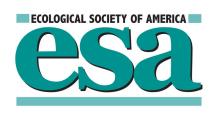Resource information
What landscapes best represent the land uses and land covers (LU/LC) of the continental United States? Would the set include a cornfield? A forest? A backyard? Combining principles of landscape ecology and computer science, we identified a small set of âexemplar landscapesâ, representing distinct LU/LC pattern types of the conterminous US. We first partitioned the 1992 US National Land Cover Dataset into 193 705 landscapes, and quantified patterns with standard measures of LU/LC composition and configuration. Using the values to estimate similarity of LU/LC patterns between landscapes, we applied an algorithm developed to find representatives in large sets. In the resulting 17âmember set of exemplar landscapes, patterns created and managed by human activity are by far the most evident features. This set of representatives summarizes the nation's LU/LC, demonstrating the degree to which humanâinfluenced patterns dominate: aggregations of rectangular fields, farmlands within cleared forests, shrublands/pasture, and suburbs. The algorithm's selection of an exemplar for each group may have other ecological applications when an objectively determined subset of representative items is needed.



